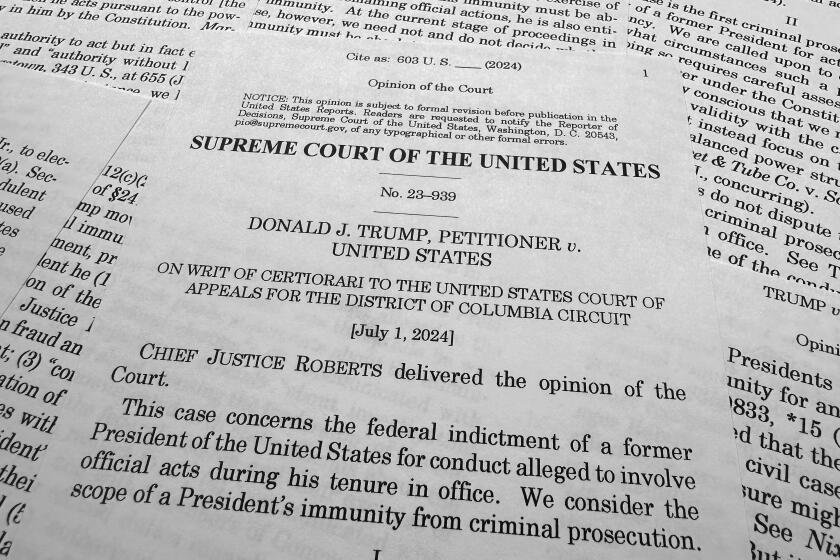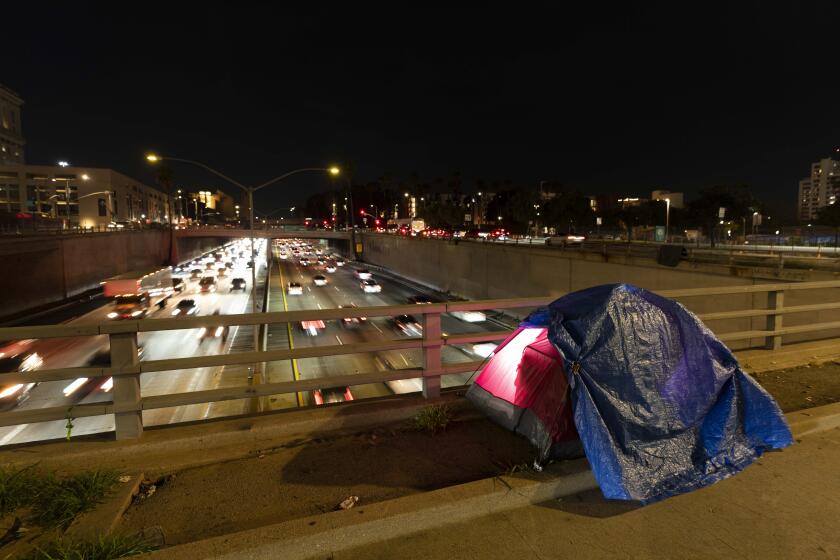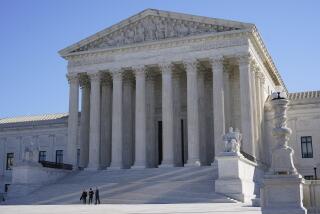Opinion: How much will the Supreme Court matter in the 2024 election?

- Share via
What role, if any, will the Supreme Court play in the November presidential election? That is the crucial, unknowable question, as the court returns from its summer recess on Oct. 7.
Will this be an election like 2000, when the Supreme Court in effect decided the outcome with its decision in Bush vs. Gore? Or will this be like 2020, when the court had no decisive role in the outcome of a very close presidential election? So much turns on whether the election comes down to one state, as it did in Florida in 2000, and whether there are constitutional issues for the court to resolve that could make it the final arbiter.
The Republican-appointed majority’s rhetoric says the president isn’t above the law, but its decision in Trump’s immunity case says otherwise.
Also, how much will the future composition of the Supreme Court matter to the voters in November? The most long-lasting legacy of any president is his or her picks for the Supreme Court and the federal bench. If Hillary Clinton rather than Donald Trump had won the 2016 presidential election, and if she had chosen three justices rather than Trump, the law would be dramatically different: Roe vs. Wade would not have been overruled, the court would not have ended affirmative action in higher education, there would not have been the dramatic expansion of gun rights, and the court would not have imposed dramatic new limits on the power of administrative agencies.
This election, too, could matter for the composition of the court for decades to come. If Trump wins, and there is a Republican Senate, Justices Clarence Thomas and Samuel A. Alito Jr., both in their 70s, are likely to retire. This would let Trump pick two justices who could be in their late 40s and early 50s, cementing an ultraconservative majority for a long time. Conversely, if Kamala Harris wins, and there is a Democratic majority in the Senate, Justice Sonia Sotomayor might step down to allow a younger liberal-leaning jurist to take her place.
As the justices begin the new term, there are 28 cases already on the docket. This is about half of the number that will be decided between now and July; the remainder will be granted review from early October and mid-January.
The homelessness and ‘Chevron deference’ Supreme Court decisions change law for the worse. They never would have happened if Hillary Clinton had won in 2016.
Of the cases so far, it’s striking how many touch on issues related to American culture wars — emotional issues that deeply divide conservatives and liberals. For example, United States vs. Skrmetti involves the constitutionality of a Tennessee law that prohibits gender-affirming care for transgender individuals under age 18. The case will matter enormously for transgender youth in the United States. A recent study concluded: “As of May 2024, 39% or 117,600 trans youth aged 13-17 are living in the 25 states that have passed bans on gender-affirming care.” In more general terms, it will reveal how this court thinks discrimination against transgender individuals should be treated under the Constitution.
Free Speech Coalition vs. Paxton involves a Texas law that requires websites where “more than one-third” of the content is “sexual material harmful to minors” to “verify that an individual attempting to access the [covered] material is 18 years of age or older.” These websites also must warn viewers about the harms of exposure to pornography. The U.S. Court of Appeals for the 5th Circuit upheld the age verification requirement but struck down the warning labels. The Supreme Court in the past has allowed restrictions on access by minors to sexually explicit materials but never limited adults. In 2011, the justices stressed the 1st Amendment rights of minors and declared unconstitutional a California law prohibiting them from having, renting or purchasing violent video games without parental consent.
A pair of Supreme Court decisions makes it clear that the government can encourage and discourage speech without violating the 1st Amendment.
Guns, too, are an issue where the country is deeply split. Garland vs. Vanderstock involves the legality of a federal prohibition against ghost guns — privately produced guns without serial numbers. The case concerns a 2022 Bureau of Alcohol, Tobacco, Firearms and Explosives regulation. The appeals court, the conservative 5th Circuit again, struck down the regulation as exceeding the bureau’s authority. The case does not involve the 2nd Amendment, but rather a government agency’s authorization to make rules. Although there certainly is a compelling law enforcement need to set boundaries on ghost guns, the Supreme Court is both sympathetic to gun rights and hostile to administrative regulations.
And for the first time in several years, the court has a major case about the death penalty on its docket. What makes Glossip vs. Oklahoma unusual is that Oklahoma has conceded error and acknowledged the state’s violation of the Constitution in not disclosing key evidence to the defense in the trial of Richard Glossip, who is now on death row for commissioning a murder. Oklahoma agreed that Glossip should get a new trial, but the state Court of Criminal Appeals refused to allow it, despite requests from the prosecution and the defendant. The Supreme Court is being asked to agree or disagree that Glossip’s execution should go forward.
The division among the justices on the Supreme Court, with six conservative justices appointed by Republican presidents and three liberal justices appointed by Democratic presidents, will matter in many of these cases. It may also be the deciding factor in the November presidential election.
Erwin Chemerinsky is a contributing writer to Opinion and the dean of the UC Berkeley School of Law.
More to Read
A cure for the common opinion
Get thought-provoking perspectives with our weekly newsletter.
You may occasionally receive promotional content from the Los Angeles Times.













